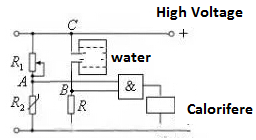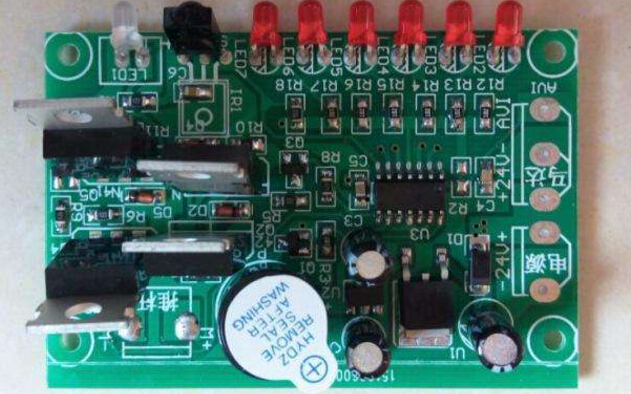How the Thermistor Works in Domestic Water Heaters?
Writer:Microhm Page View:Date:2018-11-27
The resistors in the circuit always give us the feeling that it is always dull and boring, making people feel that the resistors are unpredictable. However, it is the resistors that are constantly transforming our lives. We are no longer sighing the magic of the resistors all the time. Sometimes we feel the fun of it without knowing it.
Water heaters are already the electrical products commonly used in our homes. It brings convenience to people's lives. Many often use but don't know how it works.

R1 is the temperature-regulating resistor and R2 is the thermistor. The two inputs of the AND circuit are connected to a water level sensor and a water temperature sensor. When the water tank is full of water, point B is high voltage (that is, the input is logic 1), and R2 is the thermistor. The lower the temperature, the larger the resistance value of the thermistor, the larger the partial pressure at both ends, when the voltage reaches a certain level. When the point A is high voltage (that is, the input is logic 1), when both A and B are high voltage, the output of the AND gate is high voltage, and the heating switch of the electric water heater is turned on, in the water tank. The water is heated. When the temperature is higher than a certain temperature, the resistance of R2 becomes smaller, the voltage across R2 becomes smaller, and the heater stops heating, so the water heater is kept warm. The heater will not heat up when the tank is not full or when the temperature is high.

Through the above understanding, we can clearly know that the thermistor plays an important role in this link. Without the thermistor, our electric water heater can't provide us with hot water. It can be seen how much convenience resistors bring in our lives, making our lives simpler and more comfortable.
Water heaters are already the electrical products commonly used in our homes. It brings convenience to people's lives. Many often use but don't know how it works.

R1 is the temperature-regulating resistor and R2 is the thermistor. The two inputs of the AND circuit are connected to a water level sensor and a water temperature sensor. When the water tank is full of water, point B is high voltage (that is, the input is logic 1), and R2 is the thermistor. The lower the temperature, the larger the resistance value of the thermistor, the larger the partial pressure at both ends, when the voltage reaches a certain level. When the point A is high voltage (that is, the input is logic 1), when both A and B are high voltage, the output of the AND gate is high voltage, and the heating switch of the electric water heater is turned on, in the water tank. The water is heated. When the temperature is higher than a certain temperature, the resistance of R2 becomes smaller, the voltage across R2 becomes smaller, and the heater stops heating, so the water heater is kept warm. The heater will not heat up when the tank is not full or when the temperature is high.

Through the above understanding, we can clearly know that the thermistor plays an important role in this link. Without the thermistor, our electric water heater can't provide us with hot water. It can be seen how much convenience resistors bring in our lives, making our lives simpler and more comfortable.
Latest News
- Resistor's role in measuring and correcting LED,,,
- Single through-hole resistors' characteristics ,,,
- Why shunt resistors for current sense applicati,,,
- Metal-film resistors with small size, high resi,,,
- 36W High-Current Shunt Resistors MMS8420,,,
- 1W Surface Mount Resistor MPR1206,,,
- An Overview of Microhm Electronics' Resistor Pr,,,
- More anti-sulfur resistors used in harsh envir,,,
- Resistance changes with temperature,,,
- 140W TO247 High Power Heatsinkable Resistor,,,
- MMS5930 is ideal for current sensing in industr,,,
- Shunt resistors selection for engineers' design,,,
- Considerations for choosing precision resistors,,,
- Ceramic Encased Cement Resistors NWH Series for,,,
- Resistors for Passive Balancing in Battery-Pow,,,
Hot Articles
- Microhm will take part in 10th Automotive World,,,
- Thanks for Visiting Microhm's Booth E5-5706 in ,,,
- Resistors in Short Supply: Blame Cars,,,
- New lunch: High Power Precision Shunt Resistor,,,,
- How to Test a Resistor,,,
- Innovative Technology, Future Electric: Electri,,,
- What is Precision Resistors?,,,
- SMD Resistors Sizes and Packages,,,
- The Construction and Features of Metal Film Res,,,
- What is a TO-220 Resisor?,,,
- Hot Selling Products: Precision Shunt Resistors,,,
- How to Calculate the Equivalent Resistance Valu,,,
- What is a Fixed Resistor?,,,
- Resistors in LED Circuits,,,
- Resistors Types and Materials Overview,,,
Resistance applications
- Industrial Roberts Applied to Solar Photovoltai,,,
- The Measurement Accuracy of Automotive Shunt is,,,
- Urbanization Development Bringing the Transform,,,
- Difference Between High Precision Resistors and,,,
- Why Zero-Ohm Resistors?,,,
- Miniature future for passive electronic compone,,,
- The Main Application for High Precision and Low,,,
- Heater Blower Motor Resistor in Air Conditioner,,,
- Surface Mount Resistor's Size and Package ,,,
- The Four Important Functions of Alloy Resistors,,,
- BMS for New Energy Vehicle,,,
- Shunt Resistor MMS8420 for High Current Stable ,,,
- Precision Resistors' Construction and TCR,,,
- Carbon Film Resistors' Features and Application,,,
- Select the Right Resistor for Harmonic Filterin,,,
